One idea for an article that can be improved is Carlos Juan Finlay. Finlay was the first person to realize that yellow fever is connected to mosquitos back in 1886. However, his idea was ignored until 1900 when someone else made the claim, and he did not received credit for making this discovery until 36 years after his death. The Wikipedia article about Finlay is very brief containing only seventeen very short paragraphs. There could be expansion on his work with the yellow fever/mosquito connection and expansion on his other work. There are only two paragraphs about his Legacy, which could be expanded, and there is no information on his personal life (if he was married, had children, etc.). One source that has more information than Wikipedia is ScienceBlogs where it describes more accepts of his professional career. On the Wikipedia talk page there seems to be confusion if his name is Carlos Juan or Juan Carlos and there are comments about citation errors. If this article was to be chosen the first step would be to figure out if his name is Carlos Juan or Juan Carlos and then make sure the Wikipedia article name corresponds with the discovered information.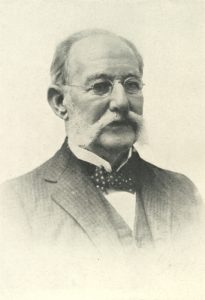
Category Archives: Uncategorized
BaoZou Big News Event
Baozou Big News Event is a very popular weekly Internet talk show in China. Starting from 2013, Baozou Big News Event has been on for 4 years and has 5 seasons. The show covers the topics of news, literature, history, psychology, geography, politics, chemistry, biology and more. The Host always wears a headgear of the Rage Comic and uses humorous words to report ridiculous news events. Since 2008, it has been watched 0.38 billion times. The show is an important component of Chinese people’s free time. But I cannot find a very updated information from the Wikipedia page. The wiki article is only two paragraphs long and it’s not even accurate. Since the talk show is closely updating, I find that the last edited time is half a year ago. In addition, the description for the talk show is painfully simple and there is nothing about several important characters which compose to the overall popularity of the talk show, for example, Wang Nima, Tang Maru and etc. The reference is also not updated and they are all the information from 2015. Therefore, we could see a huge content gap.
Link used: https://en.wikipedia.org/wiki/Bao_Zou_Big_News_Events
Possible Wikipedia Topic
After engaging in a conversation with my friend Gerald, I decided to look more into ‘Las Escualas Flotantes’ or ‘The Floating Schools.’ These school’s are designed and built in order to continue teaching children due to flooding or natural disasters that occur in their environment. This floating schools can be found in Argentina, Columbia, Bangladesh, and Nigeria. These structures are typically boat-like structures designed into a school space for children whose school’s have been shut down or destroyed due to a disaster. I believe it is important to share and shed light on this topic because it highlights the importance of education and how much we take it for granted. Unfortunately, I could not find any Wikipedia articles on this topic. I did find videos, volunteer programs, and other websites with a plethora of information. There was one page on Wikipedia connected to floating schools. The article is called “Mokoko Floating School” and describes the floating school located in Nigeria. It’s a very short wiki article with only two paragraphs (history and design). The references are books/newspapers which are all relatively modern and reliable and the links appear to work as well. The talk page did not have any discussions on it.
links used:
https://en.wikipedia.org/wiki/Makoko_Floating_School
https://www.buildabroad.org/2016/09/16/floating-schools-solution-flooding-across-globe/
Noticias 2: Pacificação nas Favelas de Rio
Link to article: http://riotimesonline.com/brazil-news/rio-politics/military-police-enter-rios-rocinha-community-after-gangs-clash/
In this Rio Times article, the author, Lise Alves addresses a recent altercation between Brazilian police/military, and gangs that occupy the favelas of Rio, specifically the Favela known as Rocinha (ho-see-nya). The news article states that police and military special forces entered the favela named Rocinha to find and arrest rival gang leaders. Firefights and battles over territory between rival gangs within the favela forced police to take action and encouraged non-violent residents to stay inside to avoid confrontation with gang members’ crossfire. The article goes on to state that the nearby metro stations of São Conrado were closed when gunfire was heard coming from Rocinha. On the northern end of the city, skirmishes between rival gangs took place the favela of Juramento.
This article gives readers a stereotypical view of Brazil that embodies the violent slums, and heavy influence of drug trafficking within them. What this article fails to mention is the results of raids by authorities. For years, Rio’s police have been battling gangs as a part of their initiative to pacify the favelas, making them safe for their people as well as visitors. This pacification movement, which was commenced in 2008, has for the most part been a total failure. Other than the success in Rio de Janeiro’s smallest favela, Santa Marta (pop. ~5,000), police have made little to no impact on Rio’s larger favelas like Rocinha (pop. ~70,000). One reason the outcomes of the police raids may have been left out is to avoid projecting a negative image towards the Brazilian Government, assuming police were unsuccessful. In addition, total pacification of Rio’s favela of Rocinha would be nearly impossible, noting the density of both innocent civilians as well as gang members. Furthermore, previous occupation of the favela in 2008 proved widely unsuccessful as police faced danger in trying to eliminate gangs while protecting themselves and the favela’s inhabitants.
This article displays both class themes, predominantly the theme of encounters. This article by The Rio Times is a common example of English news stories from Brazil, which Brazilian government fails to address. For example, in preparation for the 2016 summer Olympics in Rio de Janeiro, the Brazilian Government took many provisions to improve outsider’s views of Brazil, by simply hiding the problems rather than fixing them or providing a call to action by tourists attracted by the Olympics. For example, main roads were improved, and tunnels were added through various mountains in the city to block the view of favelas that were previously visible from the road. From my personal accounts, the views of the Brazilian people and residents of Rio seemed to be a general feeling of disappointment and despair in regards to the consistent secrecy and corruption the Brazilian Government displays.
Noticias: Odebrecht Scandal
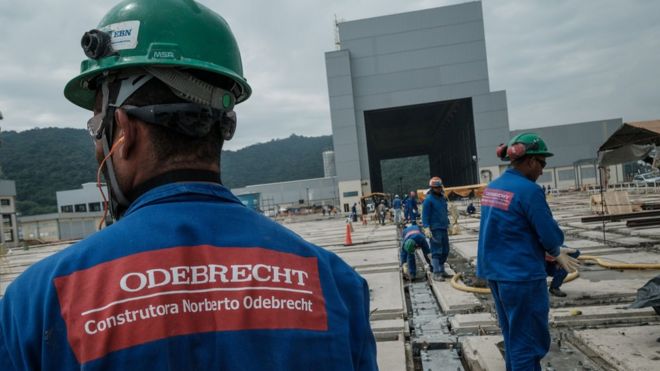 For Noticias this week, I found an article entitled “Politicians Worldwide Suspected as Bribery Scandal Unfolds”. The article was published on September 14 of this year. Right off the bat, I found this topic interesting because I have studied the faults in Latin American politics so I think this article was a good place to start.
For Noticias this week, I found an article entitled “Politicians Worldwide Suspected as Bribery Scandal Unfolds”. The article was published on September 14 of this year. Right off the bat, I found this topic interesting because I have studied the faults in Latin American politics so I think this article was a good place to start.
The article was about a Brazilian construction company called Odebrecht. This construction company has been under investigation since 2016 for allegedly bribing political officials for construction jobs in return. Odebrecht is a company that was responsible for the construction of the Olympics stadium, the infrastructure of the 2014 World Cup, as well as the metro systems, dams, airport terminals etc.
Odebrecht’s influence impacted the majority of South America, a large part of Central America and parts of even African and Europe. Since the beginning of the investigation, Odebrecht has admitted to bribing politicians to help them gain construction jobs. The company admitted to paying $349 million in bribes to Brazil alone, on top of the bribes paid to at least 12 other countries.
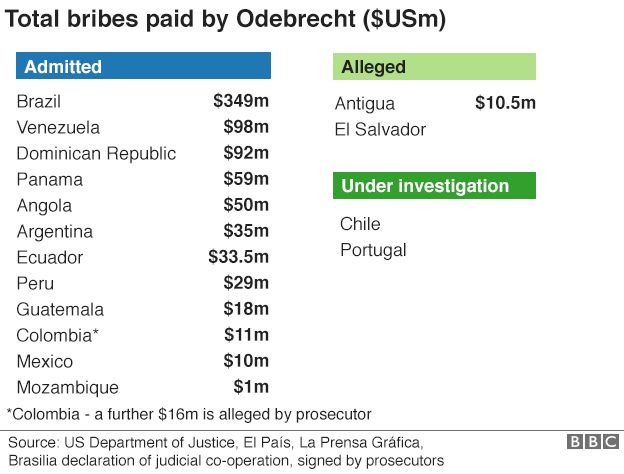 The article breaks down each country’s involvement with the Odebrecht scandal. The responses from these countries ranged from politicians having no idea that their election campaigns were being paid off by the Odebrecht company as stated by the current president of Colombia Juan Manuel Santos to countries such as Peru and Ecuador who have prohibited their elected officials from leaving the country due to the investigation.
The article breaks down each country’s involvement with the Odebrecht scandal. The responses from these countries ranged from politicians having no idea that their election campaigns were being paid off by the Odebrecht company as stated by the current president of Colombia Juan Manuel Santos to countries such as Peru and Ecuador who have prohibited their elected officials from leaving the country due to the investigation.
The article briefly explains the consequences of the construction company’s actions and how those contractors will be spending their lives. The CEO of the company, Marcelo Odebrecht, is serving a 19-year jail term which began last year after being found guilty of bribing Brazilian officials in exchange for contracts for construction.
Noticias Week 5
McCormick, Myles. ‘They lied’: Bolivia’s untouchable Amazon lands at risk once more The Guardian. 11 Sept. 2017.
In 2011 Bolivia’s Tipnis national park was declared “untouchable” which protected the land from further development. This huge victory for the indigenous people living in the area came after months of protests in Bolivia’s capital La Paz during which protesters clashed with riot police and were subjected to tear gas, rubber bullets, and other riot control techniques. These protests were sparked by an attempt to build a road through the national park, luckily the plans to build the road were abandoned after the “untouchable” declaration.1
 2
2
On August 13th, the Bolivian president signed a bill that revoked Tipnis’s untouchable status. This could mean that the road will be built through the park after all. Roughly 14,000 people live in the Tipnis national park, most of whom are indigenous. The park is also home to a diverse animal population and some studies estimate that the construction of this new road could cause up to 64% deforestation in this national park over the next 18 years. Much of this deforestation would not come from the new road on its own but would come from the people and the development that the new road would bring with it. While the native population is concerned about the new development, the government of Bolivia argues that the construction of this road is necessary to bring support services like education and medical services to the people who live in this area. To enforce their claim the government references a 2012 study that supposedly shows that the people of the area support the construction of this road however studies by an independent third party has showed that the government study was rigged. Many people in the area are not opposed to a road however they are opposed to a road that runs through the proposed area because it would be culturally and environmentally disastrous.1
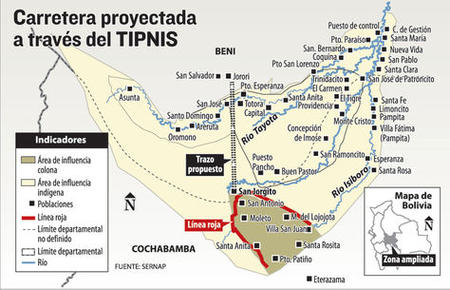 3
3
This article actually does a good job of portraying the voice of the indigenous population of the area discussed. They include arguments from the native tribes but they also conducted interviews and used direct quotes from affected peoples. My one complaint about the portrayal of the native people in the article is that they seemed to group all of the tribes together despite the fact that they seem to have different opinions about the issue.
The article I picked relates to the the course topic of identity in Latin America because this is a common clash in Latin American countries that can challenge the identity of people, especially indigenous people. When the government tries to interfere with the Indigenous way of life, even if they are trying to help, it can erode indigenous culture and identity which can in turn erase an entire way of life.
1) https://www.theguardian.com/environment/2017/sep/11/they-lied-bolivia-untouchable-amazon-lands-tipnis-at-risk-once-more
2) https://boliviadiary.files.wordpress.com/2012/03/octava-marcha-llegada-la-paz.jpg
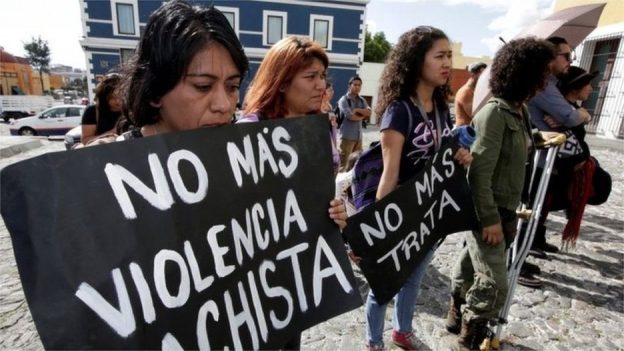
Noticias #2-Women’s Death Sparks Protests Across Mexico
On Friday Sept. 18, 2017, Mara Fernanda Castilla was found abandoned and murdered in a ditch outside of Mexico City. Mara was a young college student who decided to use ‘Cabify’ (a Spanish-ride sharing service) to get home after a night of clubbing with friends. The ‘Cabify’ app showed that Mara did make it to her destination, yet cameras never recorded her getting out of the car or into her apartment. The gruesome murder sparked an uproar and prompted activists to protests on their Independence Day parade (Sunday Sept. 17, 2017) . The activists say the country has neglected the injustice of femicides occurring in their country. Femicide is a crime involving the violence and killing of women.
The amount of murders of women in Mexico city are so high that society groups have pushed for a gender alert which was also rejected in July 2017 by the government. The article also states that statistics show that seven women are killed every day and no attention is given by the government unless they are taken to the media.
The article highlights how the government has been ignoring the intense amount of murders and crimes against women and hopes to shed light on this issue and influence the government to take better measures in preventing this atrocity.
Latin America/Mexico is portrayed as a violent environment. It is also seen as a place in need of better government that shows attention for their people. On the other hand, it also highlights the power of the people when they join together to share their dismay on the violence of women. They are portrayed as passionate individuals yearning and fighting for a change and safer environment.
Although this article is very intense, I thought it was important to showcase the violence against women. It connects to our class themes of identity because I think this is a universal topic especially considering that Mara was a current college student(similar to us) before her murder. It is something that could happen to anyone and should always be addressed. It also emphasizes how our encounters as women differ and compare in different regions.
links used:
http://www.bbc.com/news/in-pictures-41301819
https://www.theguardian.com/world/2017/sep/18/mexico-woman-murder-student-ride-hailing-service-cabify
Research Topic
1:The inequality in the income in Latin America
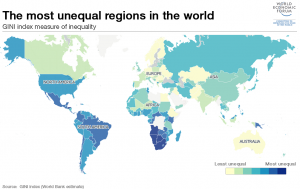 The situation of inequality is pretty much the worst in the world. High-income people don’t want to pay for the tax and are not willing to help with the infrastructure development like the hospitals, universities and cultural life. Also, the drug-related crime and governmental corruptions are the reason for some of the higher income people to lose faith in their country.This is a ferocious cycle. If the government does not try to revolutionize their inner system, the Latin American would go on deteriorating. We have to know that the latin American countries used to be the fastest growing economy, but now they are they are greatly undermined by the government corruption and drug related issues.
The situation of inequality is pretty much the worst in the world. High-income people don’t want to pay for the tax and are not willing to help with the infrastructure development like the hospitals, universities and cultural life. Also, the drug-related crime and governmental corruptions are the reason for some of the higher income people to lose faith in their country.This is a ferocious cycle. If the government does not try to revolutionize their inner system, the Latin American would go on deteriorating. We have to know that the latin American countries used to be the fastest growing economy, but now they are they are greatly undermined by the government corruption and drug related issues.
For this topic, I want to focus on the reasons the richest people don’t want to invest in their home country, to help with the economic improvement.
2:Drug Cartel in Latin America.
The reason I am interesting in this is because the drug is the serious problems across the latin America. The countries like Columbia and Peru are the major producer of cocaine and the most of the drug are exported to the North America and Europe. It is said that Mexican and Colombian generate a total of $18 to $39 billion dollars per year. And along with the profits, conflicts between major drug cartel and the crime conducted by drug cartels are always major issues in those areas. For instance, Latin America and the Caribbean has the world’s highest crime rates, with murder reaching 32.6 per 100,000 of population in 2008. And the conflicts increase as the government start to declare war on the drug cartel. For instance violence has surged in Mexico since 2006 when Mexican President Felipe intensified the Mexican Drug War.

A fully operational submarine built for the primary purpose of transporting multi-ton quantities of cocaine located near a tributary close to the Ecuador/Colombia border that was seized by the Ecuador Anti-Narcotics Police Forces and Ecuador Military authorities with the assistance of the DEA.
And especially, I want to focus on the period when Escobar became the major drug cartel in  Columbia and how it affects theColumbia people’s life.
Columbia and how it affects theColumbia people’s life.
Research Topics
My first topic of interest is the formation and history of FARC, a guerrilla movement in Colombia, that just disarmed this year, becoming a legal political party. They have roots in rural poor areas, forming during the Cold War as a communist group. In Colombia there are mixed views about them, as many urban and upperclass people don’t support the FARC as they often kidnap and ransom people, as well as commit acts of domestic terrorism. However, the government is pretty corrupt in Colombia, begging the question of whether they’re freedom fighters or terrorists. I hope to learn more about the cultural divide on FARC and urban versus rural perspectives in Colombia. Wikipedia’s page is very detailed on FARC, and there are several articles on Credo. Here’s a link to an article I read in May about the disarmament of FARC.
My second topic of interest is the 2010 earthquake in Haiti and the role of the American Red Cross. The Red Cross lied about the extent of their relief efforts, and what they did with the funds that they raised. This incident illustrates the role that America has had in Latin America, often with a savior complex that ends up being damaging to Latin America. So I would like to investigate the relief efforts in Haiti and how they’re recovering. Wikipedia has a good starting point of information, but obviously this topic is pretty narrow and there isn’t a wikipedia page for this specifically. There were a few interesting looking articles on credo, but barely any relevant ones.
Potential Research Topics
- The rights of Indigenous peoples in Latin America
- The prevalence of baseball in Latin America, specifically the Dominican Republic
With the first topic, I look to continue researching what I learned from the article I focused on for my Noticias post. Many groups of indigenous people are being discriminated against, or their rights are being infringed upon. I want to learn more about the different groups of indigenous people who live in Latin America and which Latin American countries do the best job of protecting the rights of indigenous peoples (and alternatively, which countries do the worst jobs). Below this paragraph I’ve included a link to the article I read last week for my Noticias post, as I think it provides a good starting point for this topic.
www.nytimes.com/2017/09/10/world/americas/brazil-amazon-tribe-killings.html?rref
With the second topic I’d like to investigate how baseball (often referred to as “America’s pastime”) came to be such an important part of Dominican culture. This is particularly interesting to me because I’m a big fan of the Cleveland Indians, and we have several Dominican players on our team, such as Edwin Encarnacion, Jose Ramirez, Carlos Santana, and Danny Salazar. I’ve begun researching it already and have several sources that can be used for this topic, and I’ll include a link to one below.
https://www.britannica.com/topic/Latin-Americans-in-Major-League-Baseball-910675
 Pictured is Edwin Encarnacion. Roll Tribe
Pictured is Edwin Encarnacion. Roll Tribe



